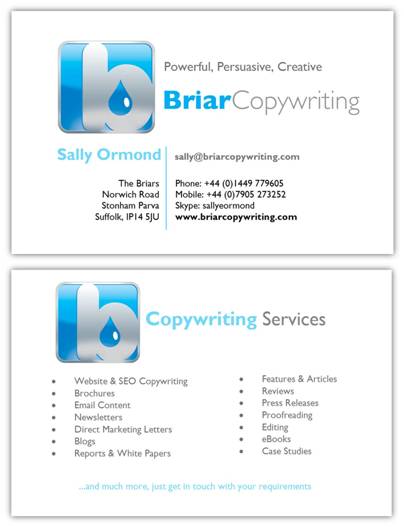 This article was supplied by printed.com digital printing, suppliers of high quality business cards members of the Direct Marketing Association.
This article was supplied by printed.com digital printing, suppliers of high quality business cards members of the Direct Marketing Association.
The author’s views are entirely his own and may not reflect the views of FreelanceCopywritersBlog.com. If you are interested in producing a Guest Post for this blog, please get in touch with your ideas.
When it comes to promoting your business, get your hand in before the competition with a business card that tells your customers who, what and where you are. Next time they need those services, they’ll know who to call.
Every business has to ‘buy’ its customers, in one way or another. Spending your budget on business cards is a very simple but extremely effective marketing strategy. There’s nothing like getting your name out there when it comes to attracting business. Not only this, but compared to placing adverts in papers or on the radio, creating business cards is incredibly cost-effective thanks to digital printing. Digital print runs are short and economical, and supply high quality material quickly. Follow these five steps to make a business card that stands out from the crowd and enhances the professional image of your business.
1. Content
Small as a business card may be, it’s all about getting the right information onto it so that your customers know who you are, what you do, and how they can get hold of you. Leave just one of these out and your cards are as good as useless. Don’t forget contact details, including a website address and phone number. Social media information is vital in this day and age: add your Twitter name or Facebook URL to broaden your customer base. Once you’ve got down the basics, it’s important to add a personal touch that demonstrates why your company will deliver above and beyond the competition. Creating a tagline that’s catchy but not flippant should achieve this. A call to action such as “Visit our website” or “Contact us here…” will put your customers on the right track. Lastly, proofread your content again and again before going to print – there’s nothing like a typo to put off potential customers.
2. Design
Your content won’t work its hardest unless layout, images and logo make it presentable. An attractive design grabs the attention, and images have the capability to convey a message as well as or sometimes better than words – and sometimes in less space. If you go for something a little bit different (check the internet for ideas on creative business cards) make sure it fits with your branding and ethos, so that it really inspires people to think rather than coming across as a gimmick.
3. Be Brand Consistent
Content, design and logo should match your wider branding, from in-store branding to website design. This strengthens your brand and reduces customer confusion. If your business card uses one colour scheme, and your website another, your branding will be weakened. Make sure your designs support and integrate with each other to make your message more powerful.
4. Quality
The best design in the world will suffer if the printing is poor quality. Choosing a print company with a good digital colour machine, and which prints on 400 gsm stock or heavier, will ensure your cards are completely professional. Business cards should ideally be coated on both sides for durability and sleekness. Ask for some test prints to make sure the design prints well.
5. Going to print
Digital printers produce the best quality cards for the least amount of money. Most companies require designs of at least 300 dpi, but ask your chosen printer for their individual guidelines and requirements. The company should be able to advise you on matters such as design and layout, and offer test prints before the full print run.
With a little effort, and attention to detail, the company will be able to produce business cards that perform far beyond the outlay invested in them. The whole face of your brand will be improved by the use of business cards, which give off a slick and professional impression. As long as pitfalls are avoided (including typos, missing content, inconsistent design and poor quality printing), your handy business cards are the ideal way to circulate the capabilities and details of your company, in a neat, pocket-sized and transportable form.







